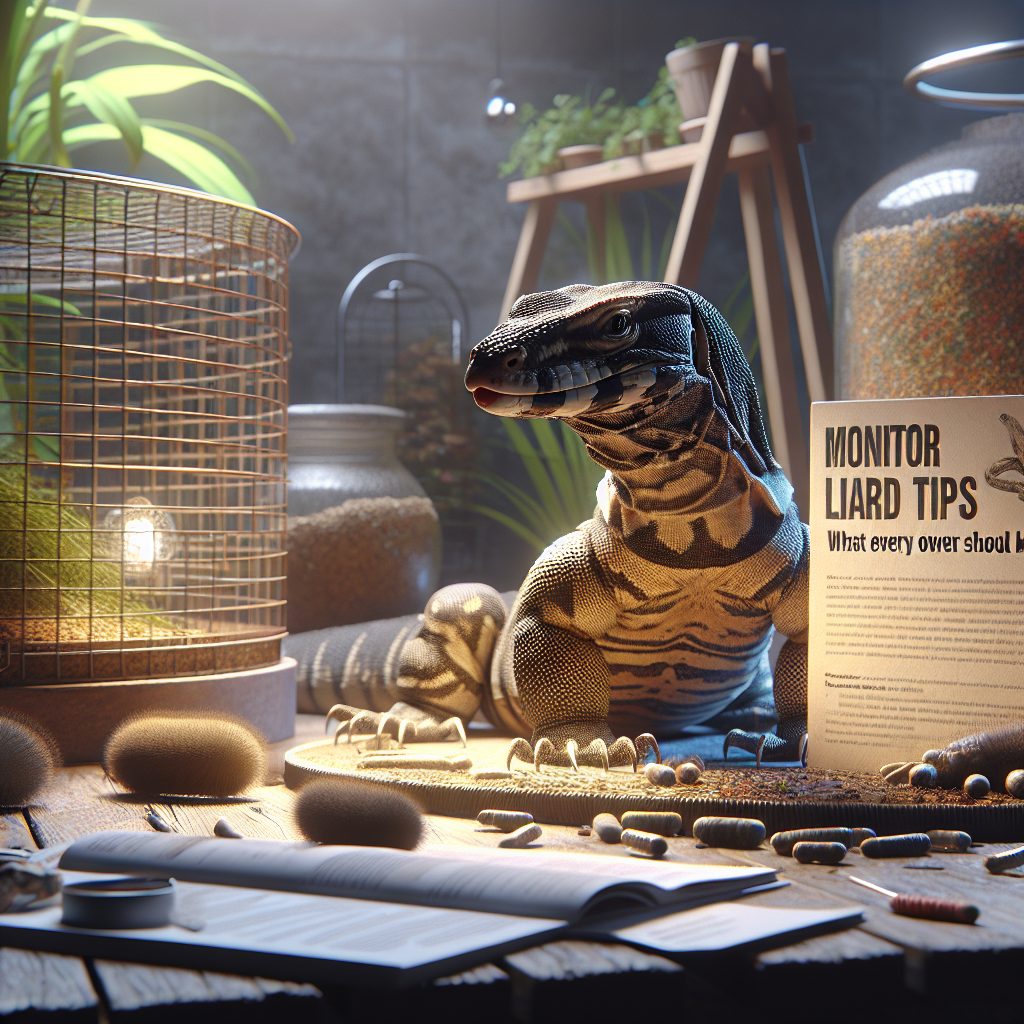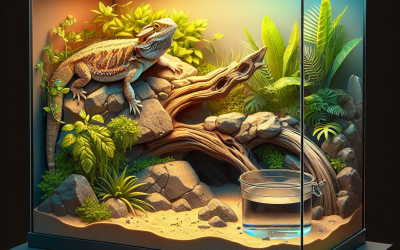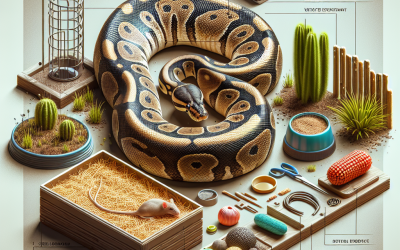Monitor Lizard Care Tips: What Every Owner Should Know
Introduction
The allure of owning a monitor lizard is undeniable. These fascinating reptiles, with their unique behaviors and striking appearances, have carved out a niche among exotic pet enthusiasts. As the popularity of monitor lizards grows, so does the need for comprehensive monitor lizard care tips. Understanding how to provide for these remarkable creatures is crucial to ensuring their health, happiness, and longevity in captivity.
Did you know that monitor lizards are some of the most intelligent reptiles? They can recognize their owners and even learn to perform tricks! However, with great intelligence comes great responsibility. Proper care involves more than just providing food; it requires a deep understanding of their habitat needs, dietary preferences, and social behaviors.
Whether you’re a seasoned reptile owner or considering bringing a monitor lizard into your home for the first time, the right care tips can make all the difference. In this article, we will delve into essential monitor lizard care tips, ensuring that you have all the knowledge necessary to create a thriving environment for your new pet.
For a broader perspective on exotic pets, be sure to check out our essential reptile care guidelines.
What is Monitor Lizard Care Tips?
Defining Monitor Lizard Care Tips
Monitor lizard care tips encompass the various practices and knowledge necessary for keeping these reptiles healthy and thriving. This includes everything from habitat setup, dietary needs, health monitoring, and behavioral enrichment. Proper care ensures that monitor lizards can lead long, healthy lives, which can sometimes span over 20 years in captivity.
Historical Context
Monitor lizards, part of the Varanidae family, have been kept as exotic pets for several decades. Historically, they were primarily found in the wild across Africa, Asia, and Australia. As their popularity surged, so did the need for better understanding and guidelines regarding their care. Many enthusiasts began documenting their experiences, leading to the establishment of communities dedicated to sharing monitor lizard care tips.
The Importance of Monitor Lizard Care Tips
As more people become interested in owning monitor lizards, the significance of these care tips has never been more critical. Without proper knowledge, new owners may inadvertently harm their pets or fail to meet their complex needs. The rise in ownership has also prompted research into the best practices for care, resulting in a wealth of resources for both new and experienced owners.
Monitor Lizard Care Tips in the Context of Pet Ownership
Understanding monitor lizard care tips fits seamlessly within the broader framework of responsible pet ownership. Just like with dogs or cats, owning a monitor lizard comes with a commitment to provide a safe and enriching environment. This includes educating oneself about their specific requirements and ensuring that they receive appropriate veterinary care when necessary.
Key Players or Contributors
Several organizations and experts have emerged as leaders in the field of reptile care. Reptile rescue groups, veterinary professionals specializing in exotic pets, and dedicated online communities all play vital roles in disseminating knowledge about monitor lizard care tips. Their insights are invaluable for anyone looking to provide the best possible care for their monitor lizard.
You can find expert monitor lizard care resources through various reputable platforms, ensuring you remain informed about the latest in reptile care.

How Does Monitor Lizard Care Tips Work?
The Mechanics of Monitor Lizard Care Tips
At its core, effective monitor lizard care is built upon understanding the natural behaviors and needs of these reptiles. It involves creating an environment that mimics their natural habitat as closely as possible. This includes proper temperature regulation, humidity levels, and providing enrichment to stimulate their minds.
Technological Foundations of Monitor Lizard Care Tips
Modern advancements in technology have significantly impacted monitor lizard care. Owners now have access to a range of tools that aid in creating the ideal living conditions for their reptiles. Some essential items include:
- Temperature and humidity monitors: These devices help maintain the appropriate climate within the enclosure.
- UVB lighting: Essential for metabolic processes, UVB lights mimic natural sunlight and are crucial for a monitor lizard’s health.
- Automated feeding systems: For busy owners, these systems can help ensure that lizards receive their food on a regular schedule.
These tools are invaluable for maintaining a stable environment, helping to reduce stress for the animal and ensuring it thrives.
Real-World Applications of Monitor Lizard Care Tips
Implementing monitor lizard care tips in real life can be straightforward if approached systematically:
- Setting Up the Habitat: Create an enclosure that provides enough space for your monitor lizard to roam. Ensure it has areas for basking, hiding, and climbing, mimicking their natural environment.
- Dietary Needs: Monitor lizards are omnivorous, requiring a balanced diet that includes insects, rodents, and plant matter. Research the specific dietary preferences of your lizard species to provide the best nutrition.
- Health Monitoring: Regularly check your monitor lizard for signs of illness, such as changes in appetite or behavior. Early detection of health issues can lead to better outcomes.
By applying these monitor lizard care tips, you can foster a healthy and enriching environment for your pet.
Essential Monitor Lizard Care Tips for New Owners
Creating the Perfect Habitat
Enclosure Size and Type (H2)
Choosing the right enclosure is one of the most crucial monitor lizard care tips. Monitor lizards vary in size, and their habitat should reflect this:
- Small species (e.g., Ackie monitor) require a minimum of a 40-gallon tank.
- Larger species (e.g., Asian water monitor) may need a custom-built enclosure that can accommodate their size and activity level.
Temperature and Humidity (H3)
Maintaining the proper temperature gradient is vital. Your enclosure should have a basking area (around 95°F) and a cooler side (around 75°F). Humidity levels should be kept between 40-60%, depending on the species. Misting the enclosure can help maintain humidity, but avoid over-wetting the substrate.
Diet and Nutrition
Understanding Dietary Needs (H2)
A well-rounded diet is essential for a monitor lizard’s health. Here are some dietary considerations:
- Insects: Crickets, roaches, and mealworms should make up a significant portion of their diet.
- Rodents: Smaller monitor lizards can consume pinky mice, while larger monitors may require adult mice or rats.
- Vegetation: Leafy greens and fruits can serve as great supplements, providing essential vitamins.
Health and Veterinary Care
Regular Health Checks (H2)
Monitoring your monitor lizard’s health is key to ensuring its wellbeing. Regularly check for:
- Weight loss: A significant drop can indicate health issues.
- Skin shedding: Incomplete shedding can signal dehydration or health problems.
- Behavior: Changes in activity levels or appetite can point to underlying issues.
Behavioral Enrichment
The Importance of Enrichment (H2)
Just like any other pet, monitor lizards require mental stimulation to thrive. Here are some effective techniques:
- Toys: Incorporate climbing structures and hiding spots within their habitat.
- Foraging opportunities: Hide food around their enclosure to encourage natural hunting behaviors.
- Social interaction: Spend time near their enclosure to help them acclimate to your presence, which can build trust over time.
By following these monitor lizard care tips, new owners can create a nurturing environment that fosters a healthy and happy pet.
Future Trends in Monitor Lizard Care
Advancements in Care Practices (H2)
As reptile ownership continues to grow, so will the advancements in care practices. Expect to see more research focusing on:
- Nutritional science: Developing better diets tailored to specific monitor lizard species.
- Enrichment technologies: Innovations in automated enrichment tools that simulate natural behaviors.
Community Engagement and Education (H3)
The reptile community is becoming increasingly active in sharing knowledge and experiences. Online forums and social media groups are excellent resources for new owners seeking advice. Engaging with fellow enthusiasts can provide valuable insights into effective monitor lizard care tips.
Conclusion
Owning a monitor lizard can be a rewarding experience, but it comes with significant responsibilities. By understanding and applying essential monitor lizard care tips, you can ensure that your reptile thrives in a safe and enriching environment. From creating the perfect habitat to providing a balanced diet and regular health checks, each aspect of care contributes to your monitor lizard’s overall well-being.
As the popularity of these exotic pets continues to rise, staying informed and connected with the community will be vital. Embrace the journey of monitor lizard ownership with dedication and enthusiasm, and your pet will surely thrive under your care.
Check out our Exotic Pet Grooming Guide for more information on taking care of your pet.
Resource Links:
- thecritterdepot.com: … Monitor lizards are skilled predators and opportunistic scavengers. Their diet includes insects, birds, rodents, fish, frogs, other reptiles, eggs, and carrion.
- reddit.com: … Care requirements are not very dissimilar to any arid lizard: sand, hot basking spot etc, so there’s nothing unique or difficult there. Monitors …
- reptilesmagazine.com: … Daily water changes are recommended unless strong filtration is set up. Caution must be exercised when setting up filtration, of course, as …




0 Comments